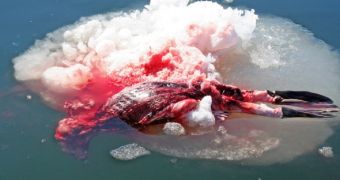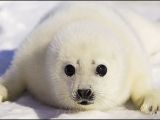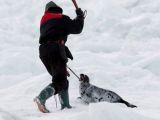Arctic is already fully feeling the global warming: thin spring ice is killing hundreds of thousands of baby seals in Canada's Gulf of St. Lawrence, provoking a delay of the annual harp seal hunt for the second successive year.
The hunt should have begun on March 28 but was re-scheduled for the end of this week, as stated officials with Canada's Department of Fisheries and Oceans (DFO).
The delay was necessary as, like in 2006, the ice floes where these seals gather to give birth and care their pups are too thin and fragile as a result of the abnormally high temperatures.
The pups, which cannot swim well and with a poor thermo-isolation against the chilly waters, are drowning by thousands.
"The ice conditions this year are so poor that the hunt should be canceled altogether," stated the nonprofit International Fund for Animal Welfare (IFAW).
In 2002, 75 % of the pups drowned due to the thin ice and the ice coverage of 2007 is even less, a record of low ice. "This is the worst ice we've had since 1981," said Mike Hammill, a DFO spokesperson.
2007 is the fifth year of bad ice since 2000, and the trend is intensifying.
"The ice that had been in the Gulf of St. Lawrence has moved out to the east coast of Cape Breton Island, where it is exposed to the battering open sea," Hammill added.
"We would expect a more rapid deterioration and breakup," he said.
Harp seals (Pagophilus groenlandicus) rely for their reproduction on sea ice in the gulf and off Newfoundland and Labrador and avoid totally the land when it's about giving birth and raising their young.
"This particular species really prefers ice over land," Hammill said.
The white-furred pups are fostered for 12 to 14 days with an extremely fat milk and after that, the mothers abandon the pups.
The weaned pups moult during the next two weeks, changing their snow-white coats, that camouflages them on the ice with silver ones spotted with small dark spots along each side.
Less ice means also less food for the weaned pups.
"The pups can't swim very well and they tire quickly. They are little butterballs of fat that pop around like wine corks. They will drown. They need the ice to rest." said Hammill.
"The seals are absolutely ice dependent, and their numbers will get hammered if it goes down." said Ted Miller of Memorial University in Saint Johns, Newfoundland.
Some experts estimate a mortality close to 100 % of the pups due to fragile ice.
Due to the situation, the Canadian fisheries ministry Loyola Hearn has decreased the number of seals tha can be caught this year by 20 %, to a total of 270,000 from 335,000.
This infamous and controversial tradition is seen as the world's largest marine-mammal hunt.
30 % of the seals are hunted in the Gulf of St. Lawrence and 70 % off Newfoundland and Labrador.
Official numbers estimate the harp seal population off the east coast of Canada at about five million animals, three times more than in the 1970s, justifying the hunt as a means of keeping under control the seal population.
But the annual quota is regarded by many as unsustainable and a population decline could occur if over 165,000 seals are caught annually.
Sheryl Fink, a senior researcher with IFAW, said that the number of the seals may be extremely over-estimated after making a flight over the area, during which she saw few seals.
"Normally, we should be seeing thousands and thousands of seals," she pointed out.
Other groups want the hunt to be stopped as it is cruel and unnecessary.
"The most recent harp seal survey, carried out in 2004, found that the pup population had been stable since 1994. The next survey will be moved up to 2008, instead of a year later as planned." said Hammill.

 14 DAY TRIAL //
14 DAY TRIAL // 

